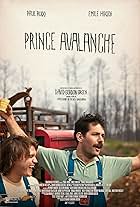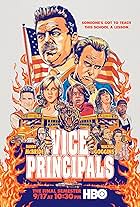The life and works of Oxford, Miss. Fireman-turned-writer Larry Brown are examined in a unique documentary format that incorporates narrative film adaptations of three of his short stories: ... Read allThe life and works of Oxford, Miss. Fireman-turned-writer Larry Brown are examined in a unique documentary format that incorporates narrative film adaptations of three of his short stories: Samaritans, Wild Thing, and Boy & Dog.The life and works of Oxford, Miss. Fireman-turned-writer Larry Brown are examined in a unique documentary format that incorporates narrative film adaptations of three of his short stories: Samaritans, Wild Thing, and Boy & Dog.
- Awards
- 3 wins total
Paul Schneider
- Voice-over
- (voice)
- …
- Director
- Writer
- All cast & crew
- Production, box office & more at IMDbPro
Featured reviews
Gary Hawkins' complex achievement shows that he, himself, is truly a gifted writer and revealer of American southern literature, while developing the fascinating and appealing struggles of living and working in Mississippi as an artist.
We are instantly drawn into the gritty, dark, and unashamed world of Larry Brown through his side projects, his humble beginnings, and most importantly, his wife. While it could have been easy to delve into a cliche and trite exposition of any artist's work, Brown's fiction requires depth of emotion and thought. Just as the viewer (not a reader of Brown) might begin to wonder what is so special about this writer, Hawkins presents his own visual renditions of several of Brown's stories, capturing the empathy and curiosity of most anyone.
Further, the way in which Hawkins weaves these pieces of fiction into the life and stories of Larry Brown is little short of masterful storytelling. Brown's past comes to life through his confessions, his doubts, and the unabashed admissions of his wife. One cannot help but wonder what relationship the director, Hawkins, developed with his subjects throughout the lengthy filmmaking process and what relationship possibly survives still.
Some of the film's overall strengths also lie in the soundtrack by Vic Chesnutt and the grittiness conveyed through "Samaritans" and "Wild Thing." To see this film is to feel as if you've spent an hour or two with Brown on his back porch, sipping some of whatever he has in his own glass.
We are instantly drawn into the gritty, dark, and unashamed world of Larry Brown through his side projects, his humble beginnings, and most importantly, his wife. While it could have been easy to delve into a cliche and trite exposition of any artist's work, Brown's fiction requires depth of emotion and thought. Just as the viewer (not a reader of Brown) might begin to wonder what is so special about this writer, Hawkins presents his own visual renditions of several of Brown's stories, capturing the empathy and curiosity of most anyone.
Further, the way in which Hawkins weaves these pieces of fiction into the life and stories of Larry Brown is little short of masterful storytelling. Brown's past comes to life through his confessions, his doubts, and the unabashed admissions of his wife. One cannot help but wonder what relationship the director, Hawkins, developed with his subjects throughout the lengthy filmmaking process and what relationship possibly survives still.
Some of the film's overall strengths also lie in the soundtrack by Vic Chesnutt and the grittiness conveyed through "Samaritans" and "Wild Thing." To see this film is to feel as if you've spent an hour or two with Brown on his back porch, sipping some of whatever he has in his own glass.
10cashjw
THE ROUGH SOUTH OF LARRY BROWN is a film of extraordinary power; Hawkins was able to elicit sincere and revealing comments from both Larry and Mary Annie Brown. He recorded the natural flow of words that provide genuine insights into what it was like to be Larry Brown, a man who determined relatively late in his life that he wanted to write fiction. His first aim was to provide financial support for his family, but ultimately he set out to express himself as a literary artist like those whom he admires, including Faulkner, Flannery O'Connor, Raymond Carver, and Harry Crews. Near the end of the film, Brown admits that he still feels in awe of his literary heroes, but, at the same time, takes pride in the degree of success he achieved. Mary Annie Brown, on the other hand, makes clear how hard it was for her and her three children during the years when Brown was working with so much determination to see his work into print.
I asked the Browns to comment on how they came to feel so at ease with the cameras intruding into their lives. Larry said that he had known Gary Hawkins "for a number of years and we became friends." Mary Annie says, "I felt that Gary . . . was a person who would not do anything that would be hurtful to us. I liked Gary the first time I met him. . . . He seemed very caring of how the film would be true to us as a family and of Larry as a writer."
The result of Hawkins's hard work is a film with at least three distinct angles. Hawkins certainly focuses on Larry Brown as a "rough South" writer, but he also put strong emphasis on the Mississippi landscape. The scenes he filmed at Larry's home near Oxford evoke the continued agrarian nature of North Mississippi: its farm land, its remoteness and its torpid heat.
When he began the film, Hawkins did not expect Mary Annie to be "such a large presence" in the film, but she became a vital part of the documentary. Hawkins has said, "You always hear about the writer, you never hear about what it's like to be the spouse of the writer." Hawkins's movie makes that connection clear.
Adaptations of three stories from FACING THE MUSIC provide the third major component of the film. He adaptation of "Samaritans" with Will Patton is particularly poignant.
Overall, and sadly, now that Larry Brown has died, the movie provides unique insights into the writer, his family, and his work that nobody else will be able to document.
I asked the Browns to comment on how they came to feel so at ease with the cameras intruding into their lives. Larry said that he had known Gary Hawkins "for a number of years and we became friends." Mary Annie says, "I felt that Gary . . . was a person who would not do anything that would be hurtful to us. I liked Gary the first time I met him. . . . He seemed very caring of how the film would be true to us as a family and of Larry as a writer."
The result of Hawkins's hard work is a film with at least three distinct angles. Hawkins certainly focuses on Larry Brown as a "rough South" writer, but he also put strong emphasis on the Mississippi landscape. The scenes he filmed at Larry's home near Oxford evoke the continued agrarian nature of North Mississippi: its farm land, its remoteness and its torpid heat.
When he began the film, Hawkins did not expect Mary Annie to be "such a large presence" in the film, but she became a vital part of the documentary. Hawkins has said, "You always hear about the writer, you never hear about what it's like to be the spouse of the writer." Hawkins's movie makes that connection clear.
Adaptations of three stories from FACING THE MUSIC provide the third major component of the film. He adaptation of "Samaritans" with Will Patton is particularly poignant.
Overall, and sadly, now that Larry Brown has died, the movie provides unique insights into the writer, his family, and his work that nobody else will be able to document.
I am a huge Gary Hawkins fan--the work is beautiful, energized, intense, and wholly original. I use this film (THE ROUGH SOUTH OF LARRY BROWN) in my narrative technique classes and students come to Larry Brown's work, but fiction-writing in general, with passion and openness after seeing the film. Hawkins tells many stories within the main story--bringing the writer and his work to life in ways that are simply stunning, unforgettable. I can't imagine not having this film! My students' favorite sections are those where all the magazine titles of all the places that rejected the stories are shown, in Brown's hand. Highly recommend.
If you're a Larry Brown fan this film is a must see, and if you love the special ambiance only central Mississippi has, then you must see it. If you're not a Larry Brown fan, I don't know what to say except that you should be. His writing should appeal to anyone who loves to open a book and get lost in it.
My favorite book was FAY so I'd suggest you start there if you haven't read him. Then see this film.
I can't get Larry Brown's face and voice out of my mind. I just watched the film last night. All the heart and sorrow and soul that you find in his writing, you'll find in his face, his eyes, and his voice, and Gary Hawkins has captured it all not just once or twice but over and over in the film.
He's shown us what it was like to be Larry Browna beautiful tribute to a man whose voice was silenced far too soon. If I ever doubted that a writer who could put words together in such a beautiful way could also be a man for the common peopleso real it hurts sometimes to watchthis film forever banished the idea from my mind.
If you're a struggling writer and want to know what it takes to make it as a writer, please don't miss this documentary. There's something here for you that's worth more than I can tell you.
I hope Gary Hawkins is working on a screenplay for a major movie based on Larry Brown's life different from a documentary in that it can be a bit more fictionalized. I see a great opportunity for a screenwriter in this man's life. I'd see the movie and I'd even buy it.
My favorite book was FAY so I'd suggest you start there if you haven't read him. Then see this film.
I can't get Larry Brown's face and voice out of my mind. I just watched the film last night. All the heart and sorrow and soul that you find in his writing, you'll find in his face, his eyes, and his voice, and Gary Hawkins has captured it all not just once or twice but over and over in the film.
He's shown us what it was like to be Larry Browna beautiful tribute to a man whose voice was silenced far too soon. If I ever doubted that a writer who could put words together in such a beautiful way could also be a man for the common peopleso real it hurts sometimes to watchthis film forever banished the idea from my mind.
If you're a struggling writer and want to know what it takes to make it as a writer, please don't miss this documentary. There's something here for you that's worth more than I can tell you.
I hope Gary Hawkins is working on a screenplay for a major movie based on Larry Brown's life different from a documentary in that it can be a bit more fictionalized. I see a great opportunity for a screenwriter in this man's life. I'd see the movie and I'd even buy it.
This is a review for the documentary film, "The Rough South of Larry Brown". The artistry in Larry Brown's writing is found in the way he tells his stories. This documentary finds artistry in the way it tells of Larry Brown. I was a fan of Brown's writing before this film. However, I don't think it is necessary to be familiar with his work in order to enjoy this documentary. This is because of the honest way it represents Brown's slow, Southern writing style. It acts as a companion to Brown's stories, style, and life. By mixing classic documentary techniques, such as interviews and family photos, with the narrative Filmmaking of three short films based on Brown's short stories, filmmaker Gary Hawkins has created a documentary that is a part of its subject as much as it is an exploration of it. Through the course of the film we are told the unique story of Brown's discovery of writing, which didn't occur until his thirties, and his subsequent development of that disciplined craft. Woven into Brown's life story are the three short narrative films based on his stories: "Boy and Dog", "Samaritans", and "Wild Thing". The insights we gain into the writing are provided by the insights we gain into the writer. We see the characters on screen struggle with their problems right alongside Brown himself. This makes us feel like we are getting a complete portrait of this person, a task not often accomplished in biographical documentaries.
Did you know
- SoundtracksFISH
Written & Performed by Vic Chesnutt
Details
- Runtime1 hour 25 minutes
- Color
Contribute to this page
Suggest an edit or add missing content

Top Gap
By what name was The Rough South of Larry Brown (2002) officially released in Canada in English?
Answer


















